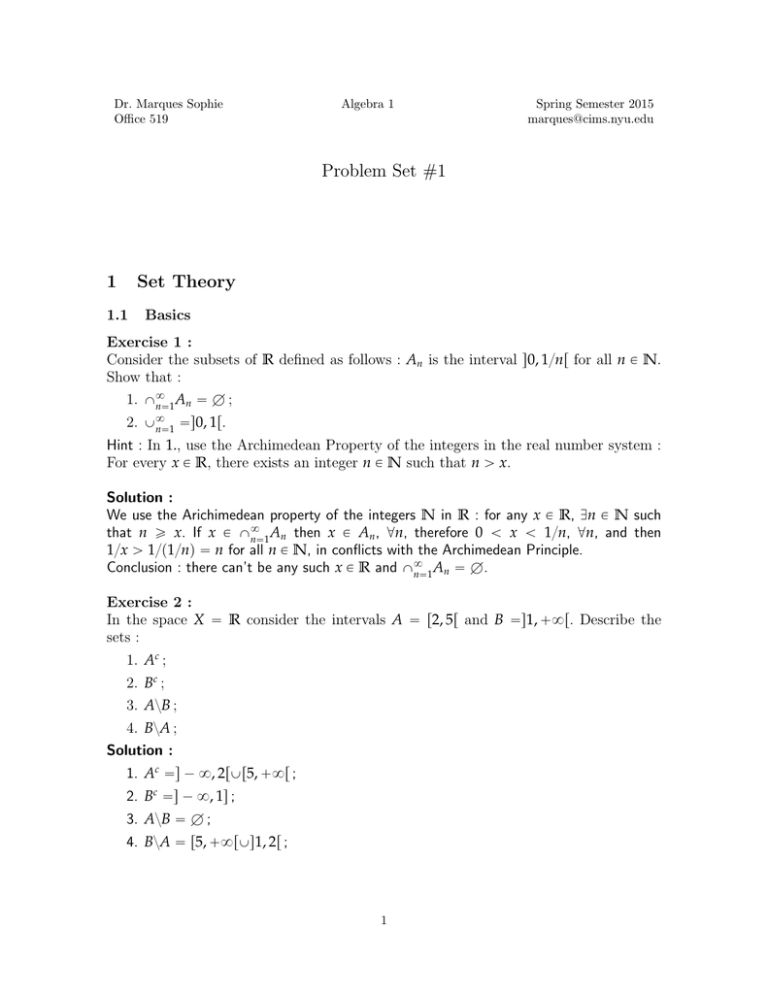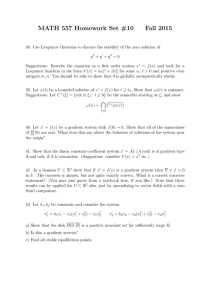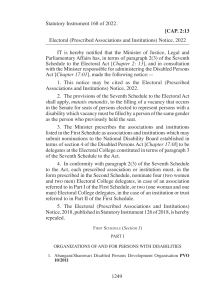Problem Set #1 1 Set Theory
advertisement

Dr. Marques Sophie
Office 519
Algebra 1
Spring Semester 2015
marques@cims.nyu.edu
Problem Set #1
1
Set Theory
1.1
Basics
Exercise 1 :
Consider the subsets of R defined as follows : An is the interval s0, 1{nr for all n P N.
Show that :
1. X8
A “ H;
n“1 n
2. Y8
“s0, 1r.
n“1
Hint : In 1., use the Archimedean Property of the integers in the real number system :
For every x P R, there exists an integer n P N such that n ą x.
Solution :
We use the Arichimedean property of the integers N in R : for any x P R, Dn P N such
that n ě x. If x P X8
A then x P An , @n, therefore 0 ă x ă 1{n, @n, and then
n“1 n
1{x ą 1{p1{nq “ n for all n P N, in conflicts with the Archimedean Principle.
Conclusion : there can’t be any such x P R and X8
A “ H.
n“1 n
Exercise 2 :
In the space X “ R consider the intervals A “ r2, 5r and B “s1, `8r. Describe the
sets :
1. Ac ;
2. Bc ;
3. AzB ;
4. BzA ;
Solution :
1. Ac “s ´ 8, 2rYr5, `8r ;
2. Bc “s ´ 8, 1s ;
3. AzB “ H ;
4. BzA “ r5, `8rYs1, 2r ;
1
Exercise 3 :
Prove the following statements from the definitions :
1.
AzB “ A X Bc
2.
AzpB X Cq “ pAzBq Y pAzCq
Solution :
Note that x P Bc ô x R B.
Now,
1.
x P A X Bc ô x P A AND x P Bc ô x P A AND x R B
But AzB “ tx P R : x P A AND x R Bu. So, AzB “ A X Bc .
2.
AzpB X Cq “
“
“
“
A X pB X Cqc pby the previous questionq
A X pBc Y Cc qpDe Morgan law
pA Y Bc q X pA Y Cc q (distributive law for ”Y”q
pAzBq X pAzCq
You can also reprove Morgan law and distributive law if you want.
1.2
Mappings
Exercise 4 :
Let S2 “ tx P R3 : x21 ` x22 ` x23 “ 1u and J : S2 Ñ S2 the inversion map Jpx1 , x2 , x3 q “
p´x1 , ´x2 , ´x3 q.
1. Is J injective ? surjective ? Bijective ? Is there a formula for J´1 (if the
inverse exists) ?
2. Let ppx1 , x2 , x3 q “ px2 , x3 q, a projection map p : R3 Ñ R2 . Let q “ p|S2 “
restriction of p to S2 Ď R3 . Find Rangepqq. Is q one-to-one ?
Solution :
1. x ‰ y P R3 ñ Di such that xi ‰ yi ñ ´xi ‰ ´yi ñ Jpxq “ p´x1 , ´x2 , ´x3 q ‰
Jpyq “ p´y1 , ´y2 , ´y3 q. Hence, J is one-to-one. Also surjective (hence bijective and
invertible) because JpJpxq “ Jp´xq “ ´p´xq “ x, implies every x P S2 is the J-image
of some point in S2 .
J´1 “ J
(J is its own inverse).
ř
2. Rangepqq “ qpS2 q “ ppS2 q. Points x “ px1 , x2 , x3 q P S2 have i x2i “ 1 ; then project
to qpxq “ px1 , x2 q. Obviously qpxq lies in the closed unit disc D̄ “ tpx, yq P R2 :
2
1, but in fact qpS2 q is all of D,
x2 ` y2 ď 1u in R2 because x21 ` x22 ď x21 ` x22 ` x23 “ b
for if px1 , x2 q has x21 ` x22 ď 1. We may take x3 “ ˘ 1 ´ px21 ` x22 q to get x P R3
with
(a) x P S2
(b) qpxq “ px1 , x2 q
Therefore, Rangepqq “ D.
The map q : S2 Ñ D is not one-to-one, indeed for any x “ px1 , x2 , x3 q P S2 with
x3 ‰ 0 and y “ px1 , x2 , ´x3 q then x ‰ y and y21 ` y22 ` y23 “ 1 so that y P S2 and
qpxq “ qpxq.
Exercise 4 :
For φ : X Ñ Y and A, B Ď X, show that
1.
φpA Y Bq “ φpAq Y φpBq
2. Give one counter example to show that we do not have always the
equality
φpA X Bq “ φpAq X φpBq
Solution :
1. We prove the double inclusion.
First prove pĎq :
y P φpA Y Bq ñ Dx P A Y B such that φpxq “ y ñ Dx P A such that φpxq “ y
or Dx P B such that φpxq “ y ñ y P φpAq or y P φpBq ñ y P φpAq Y φpBq.
Hence φpA Y Bq Ď φpAq Y φpBq.
First prove pĚq :
If y P φpAq Y φpBq ô y P φpAq or y P φpBq ô Dx P A such that y “ φpxq or
Dx P B such that y “ φpxq ñ x P A Y B such that y “ φpxq ñ y P φpA Y Bq.
Hence φpAq Y φpBq Ď φpA Y Bq.
The two sets are equal.
2. Take X “ Y “ R, φ : X Ñ Y such that φpxq “ x2 . If A “s´8, ´2s, B “ r2, `8r
then φpAq “ φpBq “ φpAq X φpBq “ r4, `8, but A X B “s ´ 8, ´2s X r2, `8r“
H.
Exercise 5 :
Taking X “ Y “ R, let f : R Ñ R be the map f pxq “ x2 . Compute the following
inverse image sets φ´1 pSq for :
1. S “ r´1, 1s ;
2. S “ the singleton t4u ;
3. S “ r1, `8r ;
3
4. S “ r´10, ´4s.
Solution :
1. S “ r´1, 1s ñ f ´1 pAq “ r´1, 1s ;
2. S “ the singleton t4u ñ f ´1 pt4uq “ t´2, 2u ;
3. S “ r1, `8rñ f ´1 pAq “s ´ 8, ´1s Y r1, `8r ;
4. S “ r´10, ´4s ñ f ´1 pr´10, ´4sq “ H.
Exercise 6 :
For X “ N ˆ N , Y “ N, define φ, η : X Ñ Y as φpx, yq “ x ` y.
1. Find the inverse of φ´1 p5q of the singleton set t5u.
2. If η : X Ñ Y is the product operation ηpx, yq “ xy, find η´1 p4q.
Solution :
1. φpt5uq “ tpx, yq : x ` y “ 5u “ tp1, 4q, p2, 3q, p3, 2q, p4, 1qu (4 points in N ˆ N)
2. η´1 pt5uq “ tpx, yq P N ˆ N : x ¨ y “ 5u “ tp1, 5q; p5, 1qu (2 points).
1.3
Finite sets
Exercise 7 :
Show that the following infinite sets have the same cardinality by finding
explicit bijections between them :
1. The sets 2Z and 2Z ` 1 of even and odd integers ;
2. The sets N and A “ tn P Z : n ď 50u ;
3. The real line R and the bounded interval s0, 1r“ tx P R : 0 ă x ă 1u.
Solution :
1. Take φpxq “ x ` 1 ;
2. Take φpnq “ 50 ´ pn ´ 1q, so φp1q “ 50.
3. One (continuous) map that does it is
φpxq “ 1{x ` 1{px ´ 1q “ ppx ´ 1q ` xq{px2 ´ xq “ p2x ´ 1q{px2 ´ xq
Exercise 8 :
Using the Shroeder-Bernstein Theorem, prove that the following sets must have the
same cardinality by producing explicit one-to-one (but not necessarily surjective) maps
f : A Ñ B and g : B Ñ A.
1. The interval r0, 1s, r0, 1r and s0, 1r in the real line ;
4
2. The unit disc in the plane A “ tpx, yq P R2 : x2 ` y2 ă 1u and the unit square
B “ tpx, yq P R2 : ´1 ď x, y ď 1u.
Solution : Show using Schroeder-Bernstein :
1. — Take f : r0, 1s Ñ r0, 1r, f pxq “ 1{2x and g : r0, 1rÑ r0, 1s, gpxq “ x (identity
map).
— Take f : r0, 1rÑs0, 1r, f pxq “ 1{2x ` 1{2 and g :s0, 1rÑ r0, 1r, gpxq “ x (identity
map).
Note that ”equal cardinality” A » B is an RST relation, so r0, 1s “ p0, 1q too.
2. A “ tpx, yq : x2 ` y2 ă 1u, B “ tpx, yq : ´1 ď x, y ď 1u ; A Ď B so for f : A Ñ B,
we can take the identity map f pxq “ x. For g : B Ñ A take gpxq “ 1{10x “
p1{10x, 1{10yq, x P B.
1.4
Equivalence relation on sets
Exercise 9 :
For n ą 1 define a ” bpmod nq to mean
b ´ a is an integer multiple of n
Verify that this is an RST relation on X “ Z.
Solution :
1. Reflexive : a „R a. Proof : pa ´ aq “ 0 ¨ 5 is a multiple of 5 ;
2. Symmetric : a „R b ñ b „R a. Proof : If b ´ a “ 5k for some k P Z then
a ´ b “ p´1q ¨ k “ 5 ¨ p´kq is also an integer multiple of 5.
3. Transitive : pa „R bq and pb „R cq ñ pa „R cq. Proof : By hypotheses, Dk, l P Z`
such that b “ a ` 5k, c “ b ` 5l. Then c “ b ` 5l “ pa ` 5kq ` 5l “ a ` 5pk ` lq ñ
c ´ a “ multiple of 5 ñ c „R a.
2
Integers
2.1
Some algebra on the sets of the integers
Exercise 11 :
Prove that in any unitary commutative ring R :
1. ´p´xq “ x where ´x is the additive inverse x ;
2. p´1q2 “ 1 where ´1 is the additive inverse of 1 ;
3. p´xq ¨ y “ x ¨ p´yq “ ´px ¨ yq, for all x, y P R.
Solution :
1. x ` p´xq “ 0 “ p´xq ` x this means exactly that x is the unique inverse of ´x,
that is x “ ´p´xq.
5
2. p´xq¨y “ ´pxyq since p´xqy`xy “ p´x`xqy “ 0¨y “ 0 ; similarly xy`p´xqy “
0. Thus ´pxyq “ p´xqy.
The proof that xp´yq “ ´pxyq is almost the same, so we omit it.
3. p´1q2 ` p´1q “ p´1qp1 ` p´1qq “ p´1q ¨ 0 “ 0. Backtracking (add `1 to both
sides), we see that p´1q2 “ 1 as claimed.
4. x ą y ñ x ´ y ą 0. But
x´y “
“
“
“
x ` p´yq “ x ` 0 ` p´yq
x ` rc ` p´cqs ` p´yq
px ` cq ` rp´yq ` p´cqsq “ x ` c ` p´py ` cqq
px ` cq ´ py ` cq
so x ą y ô px ` cq ´ py ` cq ą 0 ô x ` c ą y ` c.
2.2
Order on Z
Exercise 12 :
Prove that in any unitary commutative ordered ring R, for any x, y P R :
1. x ą y ñ x ` c ą y ` c, for all c P R.
2. x ‰ 0 ñ x2 ą 0.
3. If a ą 0 and b ą 0 then a ą b ô a2 ą b2 . (Hint : pb2 ´ a2 q “ pb ´ aqpb ` aq.
Use Rule of Sings).
Solution :
1. x ą y ñ x ´ y ą 0. But
x´y “
“
“
“
x ` p´yq “ x ` 0 ` p´yq
x ` rc ` p´cqs ` p´yq
px ` cq ` rp´yq ` p´cqsq “ x ` c ` p´py ` cqq
px ` cq ´ py ` cq
so x ą y ô px ` cq ´ py ` cq ą 0 ô x ` c ą y ` c.
2. x is either ą 0 or ă 0. If x ą 0, then we also have x2 ą 0. If x ă 0, then
´x “ p´1q ¨ x is ą 0 and p´xq2 ą 0. But p´xq2 “ p´1q2 x2 “ x2 , so x2 ą 0 in
this case too.
3. a2 ´ b2 “ pa ` bqpa ´ bq by distributive laws. Since a, b ą 0 are automatically have
a ` b ą 0 and by the rules of signs, pa ` bqpa ´ bq ą 0 ô pa ´ bq ą 0. Thus
a2 ą b2 ô a2 ´ b2 ą 0 ô pa ` bqpa ´ bq ą 0 ô a ´ b ą 0 ô a ą b, if a and b
are ą 0.
6
2.3
Induction
Exercise 13 :
řn
Prove n2 “ (sum of first n odd integers) = k“1 p2k ´ 1q “ 1 ` 3 ` ¨ ¨ ¨ ` p2n ´ 1q.
Solution : By induction : certainly true if n “ 1. If true at level n, then at level n ` 1
we have
psumq “ p1`3`¨ ¨ ¨`2n´1q`p2pn`1q´1q “ n2 `2n`2´1 “ n2 `2n`1 “ pn`1q2
So (Ppnq true ) ñ (Ppn ` 1q true). Ppnq is true for all n P N.
7









